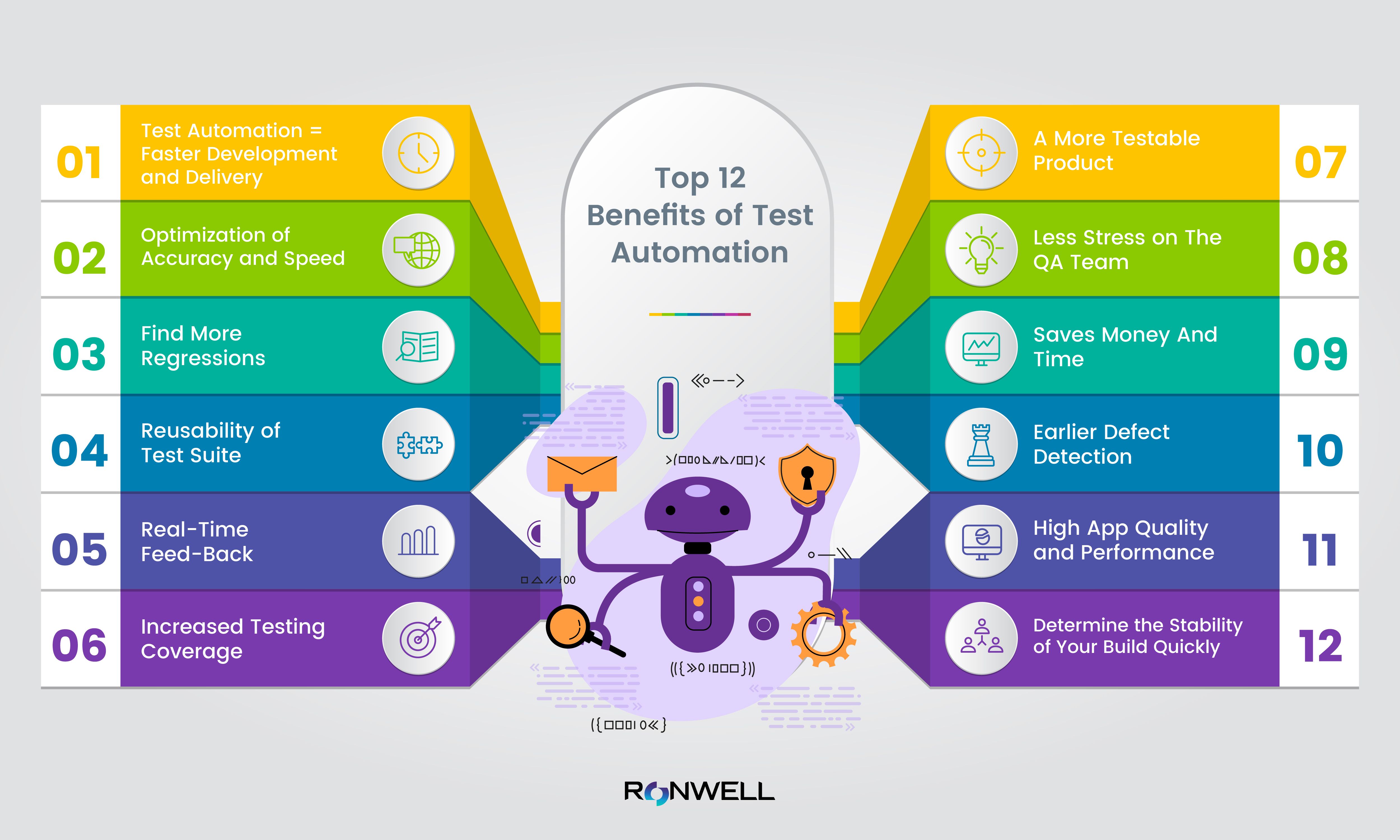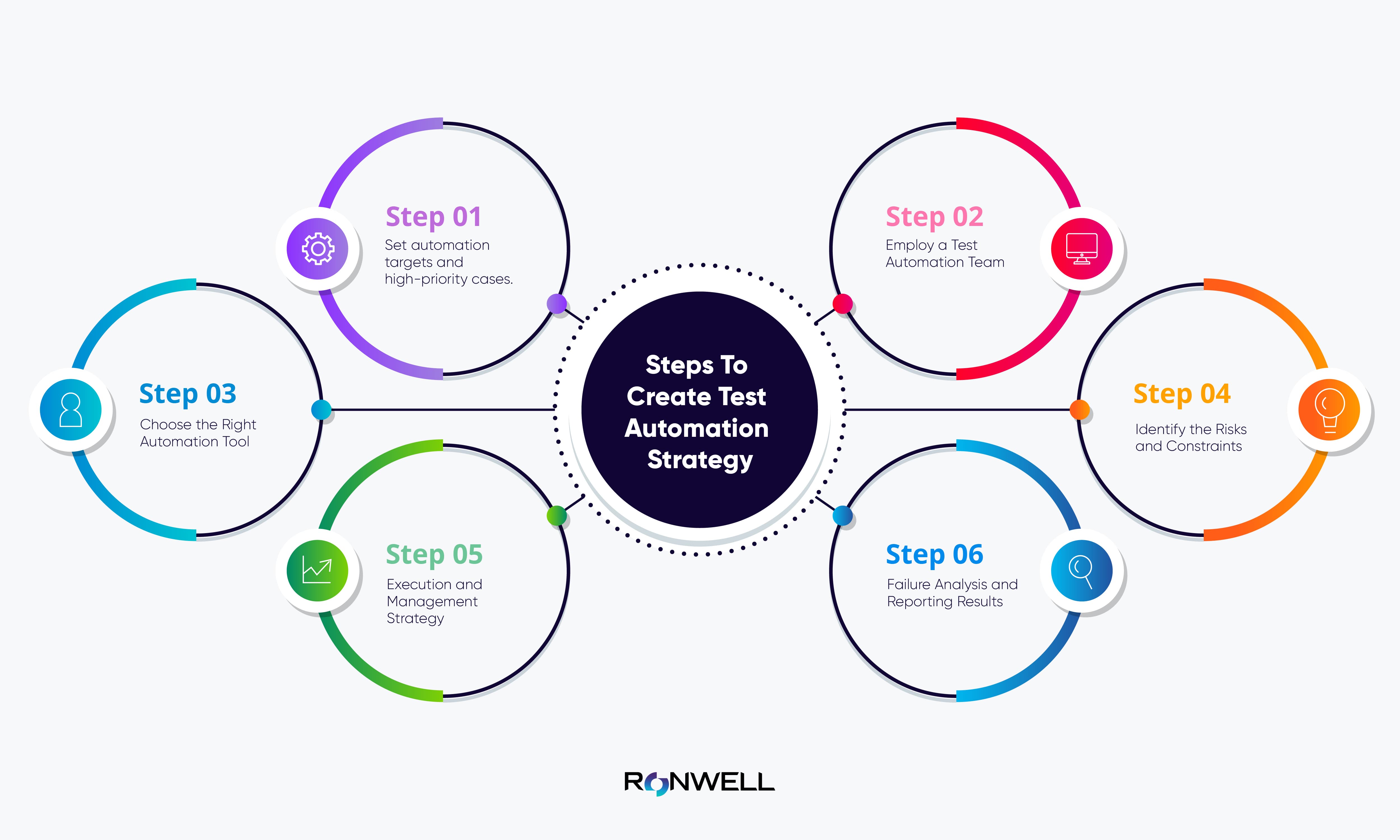

Our Services
Test Automation ServicesAI & Machine LearningBlockchainCRM ConsultingData Science & EngineeringDevOpsDigital MarketingDigital TransformationEmbedded Software DevelopmentERP Consulting ServicesManaged IT ServicesMergers & Acquisitions AdvisoryQA And Testing ServicesRobotic Process Automation SAP Consulting DevelopmentSoftware and Application DevelopmentSQL ConsultingStrategy ConsultingSustainability
- Contact Us
Our Services
- Test Automation Services
- AI & Machine Learning
- Blockchain
- CRM Consulting
- Data Science & Engineering
- DevOps
- Digital Marketing
- Digital Transformation
- Embedded Software Development
- ERP Consulting Services
- Managed IT Services
- Mergers & Acquisitions Advisory
- QA And Testing Services
- Robotic Process Automation
- SAP Consulting Development
- Software and Application Development
- SQL Consulting
- Strategy Consulting
- Sustainability
Insight
Company
Industries
- Contact Us

Test Automation Strategy: Importance, Benefits & Example
This article covers everything you need to know about test automation strategy: the benefits of test automation and steps to build a test automation strategy.
- insight
- /
- blog
- /
- test-automation-strategy
Companies must always experiment with new ideas to satisfy their customers. Risking capital on technologies that automate test cases is a worthy effort. In a world where software testing is important to the success of mission-critical applications, test automation improves operational efficiency, performance, quality, and speed.
One of the essential factors in a company's success and its customer's happiness is the presence of efficient automated testing methods throughout the software development life cycle.
The DevOps culture relies heavily on test automation, and it ends up saving us effort and time. Automating testing requires an initial investment, but saving time makes it worthwhile. After deciding to implement test automation, the next stage is to create a strategy.
In this article, we listed the benefits of test automation and the essential steps for creating a test automation strategy. Let's get started with the description of the test automation strategy.
What Is A Test Automation Strategy?
A test automation strategy is gathering all the essential data points and putting them together in a way that helps you plan what to automate, when to automate, how to automate, and which automation solution is best for your business. It's a trial run of the same procedures and tools used to determine the target audience, user types, expected testing outcomes, developer involvement, and more.
The main goal of a test automation strategy is to give complete information about the risk, capabilities, and functionality of the whole testing process. It also helps QA engineers get reliable, repeatable reports along these vectors and clearly explains the goals and plans of automation. Furthermore, it is an auditing tool, enabling QA specialists to compare and contrast their original plans with their actual implementation.
In short, a test automation strategy is a list of all the steps, plans, and goals for the testing cycle. These are the most important things:
- It explains how to set up the right test automation.
- It tells when test automation should be used and when it shouldn't.
- Choose the best test automation solution that meets all of your needs.
What's The Purpose of A Test Automation Strategy?
So, why is test automation important?
Test automation as a part of regular daily development processes is vital and influences if product quality is one of your core considerations for an application. When tests are automated in an innovative and timely way, developers (and management) can be sure that the product has been thoroughly tested while end users are using it.
Setting up and creating a reliable test automation system takes time and money. Spending time and money upfront can save a lot in the long run, thanks to a more manageable workload, fewer opportunities for human error, and more reliable test results.
Reduced time spent on routine duties frees you up to focus on more complex problems with the help of automation technology. As release cycles become shorter, automation is essential to keep up with demand without compromising quality.
What is a Benefit of Developing an Automation Strategy

Automated testing will be the dominant practice in the industry over the next few years. It's one of the most efficient and successful methods available today for expanding test coverage. Undoubtedly, it can shorten the time it takes to implement changes, cut down on manual labor, and provide you with real-time feedback.
What are the benefits of automated testing? Let's take a closer look at the principal advantages of automated testing:
Saving Time and Money with Automated Testing
To assure quality, software testing must be conducted often during development cycles. Repeating software tests is a necessary part of the development process whenever changes are made to the source code. Each software update might undergo comprehensive testing across all platforms and devices the program is designed to work with. Manually recreating these tests is time-consuming and expensive.
Compared to manual testing, creating and executing automated tests save time and money. With automated software testing, it's possible to cut down the time it takes to perform such tests from days to hours. A time advantage leads to monetary savings, and this can end up having a significant impact throughout the entire project.
Testing Automation for Developers and Testers
Using a set of standardized, automated tests, developers can identify issues before sending them to quality assurance. When new code is checked in, the tests can be automatically performed, and if they fail, the team or developer can be notified.
These enhancements are a huge time saver and morale booster for programmers.
Testing Improves Accuracy
In manual testing, the quality of coverage depends on the tester's experience and exposure. Test automation eliminates the need to adjust for these variables and consistently produces the desired outcome when adequately implemented. Another factor that affects quality is human error. No matter how careful a quality engineer is, they may make a few mistakes along the way that will result in a low-quality application. Your solution will perform the processes without error and report them without bias if you first put them through a range of automated tests.
Contributes to Continuous Testing
Continuous testing is a method that testers use to get immediate feedback on the business risks of the application they are testing. In this method, automated tests run in a loop without stopping, enhancing bug reports and reducing business risk.
With DevOps, teams can work together more effectively because of continuous testing's central role in the process. Test automation facilitates quick application testing, which is essential for continuous testing.
For further information about DevOps, read our article: What is DevOps?
Increases Your Test Coverage
Automated software testing can enhance software quality by increasing the depth and scope of tests. Long tests are often skipped when testing by hand can be run by itself and can even be used on multiple computers with different setups.
We can examine the product's memory, data tables, file contents, and internal program states through automated software testing to check if they are operating as planned. Test automation makes it easy to run thousands of different, complex test cases during each test run, giving coverage that is impossible with manual tests.
Also, automation gives you time to write new tests and add them to your suite of automated tests. This means that more of your product's features will be tested correctly, improving your application.
Reduced Stress On The QA Team
By using automated testing, you can free up your QA team to do things other than manual testing. Also, a QA engineer's job becomes more interesting once you remove the repetitive parts of manual testing.
Testing automation allows many QA engineers to build new tools to improve the current testing suite or add to it with new features.
Quickly Determine the Stability of Your Build
Using automated testing, you can quickly and easily assess the reliability of your build. Smoke testing is frequently used to verify stability. Smoke testing, however, is laborious since it necessitates the testing engineer's active participation in the process, such as when creating databases to store test results.
Also, test automation can help you automate smoke tests. Automatically creating and setting up the proper databases for running smoke tests is now possible. As a result, you can quickly assess the structure's steadiness.
Together, these two features will allow for rapid build releases and automated stability testing.
Improved Insights
When some tests fail, the insights gained through automated testing are superior to those gained from manual testing. Automated software testing can glean insights into the program's memory, data tables, file contents, and other internal states, and developers can use this information to figure out what went wrong.
Reusability of Test Suite
Creating an automated test suite is difficult initially. When your suite is defined, it's easy to recycle tests for new use cases or projects. One benefit is that your automated test suite can quickly and readily integrate with new projects.
You are well-versed in the fundamentals of establishing a CI pipeline and other technologies necessary for automated testing. As a result, you will not have any trouble using this information to build up test automation for another project.
Provides Quicker Feedback
Automatic testing has the additional advantage of providing immediate results. Delivering greater quality and a good user experience relies heavily on this feedback loop between developers and testers. Manual testing is more time-consuming because of the need to locate and isolate the problem before attempting a remedy and testing the improved functionality.
Quicker responses imply less time spent correcting bugs and more time serving users. In particular, if your product is currently available, you may make adjustments to keep customers happy.
In addition, your time investment will be minimized if your automation service has pre-defined keywords available.
Easy Reporting Simplifies Life
It takes a lot of time and effort to generate reports while conducting manual testing. It necessitates maintaining a dynamic dependence between the rate at which test scripts are created and the rate at which defects are repaired. The reporting process is simplified with automated testing. Screenshots and videos of each step being executed are provided in a test automation solution, making locating and rectifying the problem simpler.
Guarantees Data Privacy
The success of your testing mostly depends on the quality of your test data. Unfortunately, testing on copies of live databases takes time, and quality test data must be created manually. You can build, secure, and use your test database with the help of test automation technologies.
Allows for Scalability
Manual testing can be scaled to a certain extent, but doing so requires more resources and time, which might delay releases. Putting more people to work on a project means "scaling" in manual testing, and it takes time to get them on board and train them.
However, test automation can be easily expanded in a couple of minutes. In other words, the test automation system just needs additional test executors.
Faster Development and Delivery
In product development, fixing defects is one of the highest costs that isn't taken into account. The time and effort required to resolve a defect in code increases when there is a significant lag between its development and discovery.
Automating tests strategy comes into play here. To ensure that the code is functioning as expected, it is essential to establish a more robust feedback loop between the two processes. When test automation is prepared to run as soon as code is complete, what used to take developers days to change because they had to relearn their code written months ago can now be done in minutes.
One of the numerous benefits of automated testing is a lower total cost of quality problems. Think about how much it would cost if testing slowed down development and you missed out on potential market prospects. The possible cost of not acting in this way might be fatal to a business.
To quantify the benefits of test automation on delivery times, it is possible to compare the amount of time it took to deliver before and after implementing such systems. Time spent on defect discovery, prioritization, and resolution by developers, product managers, customer service representatives, testers, and anybody else is included in the total before test automation is developed.
Then, after using test automation, re-evaluate the outcomes. Multiply the total hours worked by a fair hourly rate considering benefits (often 40% or more of income).
The return on investment (ROI) will be calculated by dividing the net profit (the value we just discovered) by the initial investment. You have a profit if the result is more significant than 1, and any other outcome would result in a loss of money.
We help companies realize the full potential of test automation. We provide customized test automation services to meet the unique requirements of your project.
To find out more about the services we offer, check out our Test Automation page.
Find More Regressions
It is common for regressions to happen more often after test automation has been added. The critical difference is that nowadays, regressions can usually be detected immediately and rectified quite simply. Therefore, they aren't always reported. In a continuous integration (CI) environment, a developer may notice a failed test, identify it, and correct it without documenting it. So, it may require a bit more work to count the regressions that are discovered.
Count how many regressions before and after test automation was put in place, and give each one a value. Averages are good to know. Calculating the benefit from test automation is as simple as comparing the average cost per regression fixed before automation with the number of regressions fixed after automation. The goal is for the average time it takes to fix a bug to go down over time and for the number of regressions to increase over time.
Finding more regressions can cost you more now, but this is a big difference from how much it used to cost users to find them.
A More Testable Product
People who are committed to using test automation throughout the product development process naturally produce more testable products.
An organization can use either a qualitative or quantitative approach to define the advantages. Ask test automation engineers with a lot of experience if your product is easy to test. They will be able to answer quickly.
How long does it take your product to write a test for a feature? Can provide you with some numbers to work with. When this time goes down over long periods, you're making progress toward testability. When a product is easier to test, you can get it to market faster, test it in more ways, and miss fewer use cases. Stakeholders and product owners prefer more testable products because they increase trust in their capabilities.
Teams usually get better test and code coverage by adding test automation to their testing efforts, making the product more testable in the long run.
Earlier Defect Detection
By recording software errors in a database, automation testing makes testers' lives a lot simpler. The development and support teams can more easily discuss the issues and devise solutions.
Incorporating these improvements into the project's development process accelerates progress without sacrificing quality or correctness in any key areas. The earlier a problem is discovered, the faster and more cheaply it can be fixed and used.
High App Quality and Performance
Automatic testing will guarantee your app is of the highest quality and performs optimally because of the comprehensive nature of the tests it runs. With this tool, you can run hundreds of automated test cases at once, making it simple to check your app on various operating systems and mobile gadgets. Choose cloud-based device farms if you wish to maximize test parallelism and concurrency. They will assist you in covering all necessary OS and hardware configuration variations.
Automated testing makes it easy to quickly generate simple and sophisticated, lengthy, and time-consuming test cases. If you decide to test your app manually, you will never be able to accomplish this.
Steps To Create Test Automation Strategy
Now that you know what a test automation strategy is for and how it should look, we can get into the details of how to build one.

Step 1. Set automation targets and high-priority cases.
Planning is the first stage of every successful endeavor, and it's the same for automated testing. Prioritize intelligently if you cannot or do not need to automate everything if you are focused on high ROI. That's why the most crucial thing at this point is to specify the scope of testing.
Recurrent, tedious, and time-consuming operations are the easiest to automate. At the same time, only the most practical situations merit the investment.
Focus on test scenarios that:
- are critical from a business point of view;
- carry a high risk of failure;
- have to be executed repeatedly;
- involve large data sets;
- tests different browsers/environments/devices/operating systems (OSs);
- can't be performed manually or take a lot of time;
- result in a clear Pass/Fail; and
- check stable features.
Considering this, some of the most practical tests that can be automated are:
Unit tests offer the best ROI and should ideally constitute the backbone of any automated testing plan. Developers may develop unit tests to examine the tiniest portions of their code and uncover flaws on their own.
Integration/API testing: as recent apps rely primarily on APIs (Application Programming Interfaces), testing them helps you to check the app's behavior and business logic. It makes it logical to automate as much of your API testing as feasible. Prioritize situations that require regular testing. Identify where the modifications to the code might influence the API functioning and target those areas.
Regression tests: one of the things that can drive anyone crazy is discovering that a long-cherished feature no longer functions following an update. You must examine whether it breaks the current components each time new functionality is put into your program. Regressions should be your next priority, as they repay investments after each successful build.
Cross-browser tests: it's challenging to guarantee your product works correctly on all devices/OS/browsers/screen resolutions with manual testing alone. To enhance the ROI from test automation, examine your target audience's most common combinations and focus on high-risk features.
Data-driven tests: it would be incredibly time-consuming to manually input every conceivable combination of correct/incorrect username and password. But with automation technologies, generating this data is quick and straightforward. Automated testing can create enormous volumes of quality data for manual tests.
Step 2: Employ a Test Automation Team

If you already have a team of TA engineers working for you, you can skip this step and proceed to the next. Once you've settled on the scenarios you'll be testing; it's time to assemble the crew to implement those plans.
Finding a qualified automation engineer who can also create complex scripts might be challenging. To help you encounter fewer problems in the future, here are some suggestions:
Observe whether the TA specialist decides which situations should be automated. As we've shown, it's a bad idea to automate every possible scenario, as doing so would increase administration overhead and decrease the value of execution outcomes. An expert TA engineer knows how to evaluate the importance of automating a given use case, its feasibility, and whether or not the use case should ever be automated.
Select engineers that have worked with a wide range of equipment. If you just have one or a few tools that your TA expert uses, you lose their expertise in other areas and their independence. An effective TA engineer will be receptive to developing novel test automation tools and keeping current with the most advanced commercial and free options.
Describe your needs. You need to go in with a clear idea of what you want to find. Find out what kind of exam you wish to administer instead of just reading through engineer resumes to ensure a candidate knows their stuff.
At Ronwell Digital, we help companies that don't have experience with test automation get all the benefits that come with it. We offer test automation services specific to your requirements and the needs of your project.
Visit our Test Automation service page to learn more about what we offer.
Step 3: Choose the Right Automation Tool
When developing an approach to automated testing, selecting a testing tool suite is essential. Make sure that any script execution software you choose will only serve to enhance the procedure rather than hamper it. The current landscape is saturated with options, offering a seemingly endless list of benefits. That's why a developer needs to have a set of guidelines for validation.
A quality assurance expert's decision on a particular suite of instruments can be affected by the following:
Complexity: Your team could be concerned about adopting a new programming language to use the product effectively if it does not already have extensive expertise with automation. You should learn as much as you can about your QA experience, skills, languages spoken, and tools used. Also, avoid selecting robust software for minor testing jobs; the quantity of capabilities will slow down the process rather than speed it up.
Technical feasibility: If you want to take advantage of the critical benefits of automated testing, you need a tool that can run tests autonomously, collect data for reports without human intervention, run many tests simultaneously without needing precise screen coordinates, and so on.
Testing Data: You should use a program with several options for handling your data. In this manner, you may avoid using many data collection and analysis programs.
Script Reusability: If you want to save time on future projects, use a program that can keep your scripts in a database.
The ability to run scripts under different settings. To successfully transfer a script to a new environment, the tool of choice must be able to automatically modify any environment-specific data.
Step 4: Identify the Risks and Constraints
While risk analysis is essential throughout the project lifecycle, its importance is magnified by automating tests. To conduct the risk analysis, the following data is compiled and attached to each potential risk:
Identify the potential risk:
- Severity: this solves the question of what will happen if the risk occurs and how it will affect the project.
- Probability is the explanation of the chances.
- Mitigating risks involves explaining how they may be reduced or avoided.
- Cost estimation involves both factors in the price tag for taking precautions and deciding whether or not to ignore the risk altogether.
Step 5: Execution and Management Strategy
The test automation plan should outline the procedure for running and maintaining test cases. Procedures and duties for test automation should be included in the execution and management plan.
Select the cases that should be automated and run them repeatedly to ensure they behave as expected before incorporating them into the regression suite. The next step is establishing standards to ensure your test cases remain unchanged no matter what you do to the automated system. Automated testing allows us to specify how test cases interact with various application parts.
Pipeline orchestration and scheduling tools are required to run test cases concurrently. A lot of time is being saved as a result of this.
Assigning a success or failure status after the tests' execution is one of the easiest but most crucial steps. If the result is a "fail," more investigation into the cause of the failure is warranted.
Step 6: Failure Analysis and Reporting Results
It is essential to have a method for analyzing and fixing failed test cases as part of your test automation plan. It usually takes much longer than expected to detect the failure, investigate it, and remedy it. The development team may save time and energy if they have a clear procedure. Explain how various mistakes should be dealt with.
These mistakes can include the following:
- Problems with the test environment - notify the DevOps staff.
- A flaw in an application under testing - Flag a flaw for the development team
- A bug in the automation scripts – Create a duty for the testing group.
Next, it's essential to keep track of everything you've done so far for future reference. This includes your strategies to apply automation, test outcomes, and the benefits and drawbacks of your test automation plan. Then, you continuously refine your test automation approach by absorbing the lessons of past failures, and the strategy for automating tests needs to be updated.
Now that you know what's needed to create a powerful and efficient test automation strategy, you can get started.
Test Automation with Ronwell Digital
You should contact Ronwell if you are seeking a group of skilled testers and automation experts. Our team will establish and implement an automated testing strategy that aligns with your company's development approach.
Professional services provided by Ronwell can help your applications run more smoothly and efficiently, allowing you to save time and effort on quality assurance.
Our consultants are also used to dealing with the small details of organizing compliance documentation and giving the right advice to ensure that products meet the quality standards of different industries.
With Ronwell's automated testing and QA services, you will have complete control over the testing and deployment of your product.
Writer:

Halime Yılmaz
Content Marketing Specialist
13 min read
8 November 2022, Tuesday
Related Posts
Related Industries











